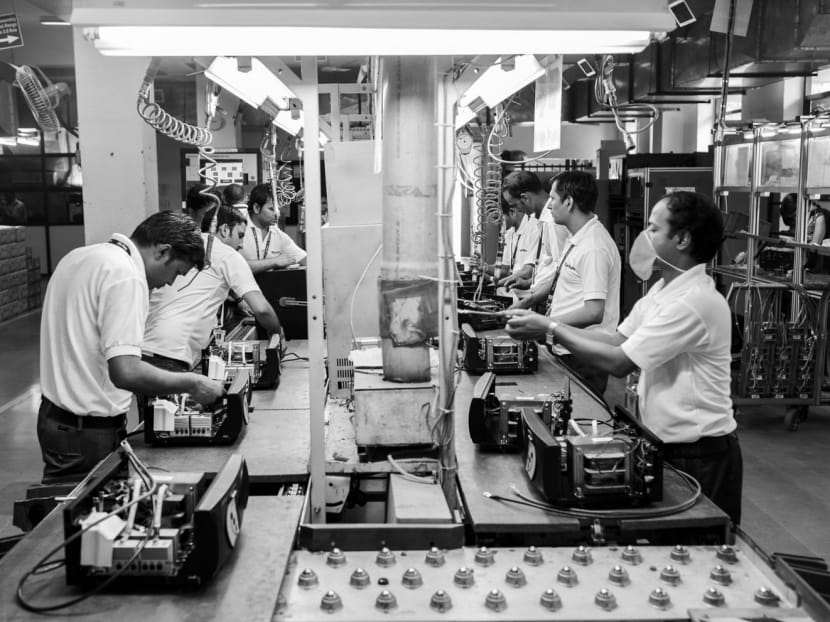India chooses iPhones over asset bubbles
India’s Raghuram Rajan is an outlier in Asia. Whereas other central bankers in the region are pumping ever-more air into asset bubbles — New Zealand and South Korea further reduced interest rates last week, and Australia may be next — Mr Rajan has taken a go-slow approach. It is to Mr Rajan’s credit, and India’s benefit, that he has shown such discipline.

Workers at an assembly line in India. Many tech firms are eyeing alternatives to China’s rising labour costs and slowing growth. Photo: Bloomberg
India’s Raghuram Rajan is an outlier in Asia. Whereas other central bankers in the region are pumping ever-more air into asset bubbles — New Zealand and South Korea further reduced interest rates last week, and Australia may be next — Mr Rajan has taken a go-slow approach. It is to Mr Rajan’s credit, and India’s benefit, that he has shown such discipline.
The Reserve Bank of India governor has done his share of easing this year, most recently on June 2. But he has not tried to keep up with his peers in the region: Short term rates in India are still 7.25 per cent compared to 5.10 per cent in China, 3.25 per cent in New Zealand and less than zero in Japan. Nor has Mr Rajan followed others in tweaking bank reserve requirements and margin-lending rules to drive up stock prices. It is no coincidence that Mumbai shares are down 5 per cent this year, while Shanghai’s are up 60 per cent.
Instead, Mr Rajan, a savvy University of Chicago economist, has been holding Indian Prime Minister Narendra Modi’s feet to the fire. Mr Rajan has made more monetary stimulus contingent upon progress on the structural reforms Mr Modi promised more than a year ago when his Bharatiya Janata Party campaigned in national elections. When he cautioned against “competitive monitoring easing” last week, Mr Rajan was letting the government know he would not be pressured by the rate-slashing in other countries.
Specifically, Mr Rajan is prodding the government to step up infrastructure spending. He wants to make sure Mr Modi makes good on his proposed budget, which promises a 25 per cent increase in outlays on roads, bridges and ports to increase India’s competitiveness.
Mr Rajan and Mr Modi were both probably buoyed by recent news that tech giant Foxconn Technology is looking at manufacturing Apple’s iPhone in India. It is an endorsement of the country’s current economic stewardship and an indication of India’s broader potential as a manufacturing hub, especially given China’s determination to move its production upmarket from basic manufacturing to software design, aerospace and robotics.
But if Mr Modi hopes to reach the full potential of his “Made in India” campaign, it will require bold government action — action that Mr Rajan’s quid pro quo strategy could help motivate.
There is plenty more Mr Rajan should do. His team has been rewriting rules to help lenders recover loans from defaulting companies, but he should accelerate those efforts. Even after three rate cuts, India’s loan growth is dwindling; in the words government advisor Arvind Subramanian, the “corporate sector is unusually stressed”.
In fact, the country’s stressed assets are projected to rise to a 15-year-high in 2016, while bank default risks are rising more than anywhere else in Asia.
In order to address India’s inflation problem — which, unlike elsewhere in Asia, stems primarily from inefficiency and corruption — Mr Rajan should encourage the government to simplify taxes, cut red tape, open protected sectors, eradicate graft and liberalise land laws. In addition to narrowing the gap between rich and poor, those steps would help attract more business from Foxconn and its global peers.
Like the Taiwan-based behemoth, many tech companies are eyeing alternatives to China’s rising labour costs, slowing growth and weak intellectual-rights protections.
But the basics of Mr Rajan’s strategy are entirely correct. Unlike his peers in China, Japan and elsewhere in the region who have enabled the complacency of their governments, he has done the opposite.
In the short term, India may miss out on the excitement of rapidly growing asset bubbles. But attracting the Foxconns of the world more than makes up for it. BLOOMBERG
ABOUT THE AUTHOR:
William Pesek is a Bloomberg columnist based in Tokyo and writes on economics, markets and politics throughout the Asia-Pacific region.






